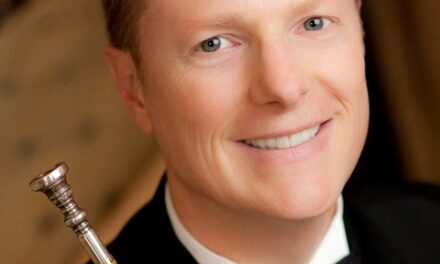 How do we proclaim universal truths in silence? Can we ponder human existence without using words? Three lone dancers in white moved under a wash of light on an empty black stage: It’s not the start of a joke, but a description of postmodern dance legend Trisha Brown‘s 1975 “Locus,” as varied and performed by UNCSA School of Dance students for the department’s Spring Dance Program. In “From Within and Beyond the Cube: Variations of ‘Locus’,” everything from the first law of thermodynamics to the nature of human relationships is prompted, simply using the body – in utter silence.
How do we proclaim universal truths in silence? Can we ponder human existence without using words? Three lone dancers in white moved under a wash of light on an empty black stage: It’s not the start of a joke, but a description of postmodern dance legend Trisha Brown‘s 1975 “Locus,” as varied and performed by UNCSA School of Dance students for the department’s Spring Dance Program. In “From Within and Beyond the Cube: Variations of ‘Locus’,” everything from the first law of thermodynamics to the nature of human relationships is prompted, simply using the body – in utter silence.
“Locus'” was the eighth piece on the School of Dance’s program, a livestream which featured just about every dance student (according to the school), premiered April 30th, and will run weekends through May 8th. The entire show was a balance between classical and contemporary, featuring acts from ballets Don Quixote and Coppelia, as well as four new contemporary works by UNCSA faculty and guest choreographer Gaspard Louis, a former dancer with Pilobolus. “Locus” was second to last on the program and featured dancers Faith Fidgeon Jordan Hooks, and Kendall Marie Ramirez. It was directed by former Trisha Brown Dance company member and current associate professor Abigail Yager. The dancers began downstage left in a sort of clump, facing more or less inwards, towards each other. Once they began dancing, the movement was continuous: there were few pauses (if any), and the dancers moved at different times, making it so that even if one dancer was still, movement remained.
The dancers moved in lose shapes and pedestrian movements (a staple of Brown’s legacy) with no particular outstanding dynamic, changing directions and levels abruptly and often, and though on a proscenium stage, hardly moving across the space at all. It was absolutely captivating – hypnotic even. Though dancers moved independently from one another, the viewer began to see patterns in movement and repetitive actions which ricocheted between the dancers. An arm would go up by “dancer one,” and then suddenly the same arm would go up in the same way on “dancer two,” while “dancer one” had long since moved on to something new. It was like spontaneous generation: I found myself asking where the movements were coming from – was it first the chicken or the egg? – but then realizing it could be neither, as there was no clear beginning nor ending. The dancers showed that no movement was created nor destroyed, but simply existed, transferred, and transformed through the dance.
In “Locus,” the dancers never touched and mostly danced differently. Every once in a while, however, two or all three dancers would be in unison for a brief moment – an incredible feat for dancers with no sound cue and rare eye contact, as they often faced in separate directions. This use of different facings, though often still remaining close together, opened the stage exponentially, almost like a room full of mirrors where it is difficult to know where you are and what exactly you’re seeing, but suddenly are given an omniscient-like perspective. All of the sudden you begin to question your own presence – what space you occupy and with whom; also, what is to be done with that space? Perhaps most surprising was not just the fact that all of these philosophical musings (and more) could come out of a silent, rather anti-climactic (purposefully), visually tame performance, but that it was able to do so even through a computer screen.
The screen did not hinder the other performances of the evening, either. The UNCSA School of Dance always impresses with technical proficiency and this evening was no exception. In Don Q and Coppelia, dancers performed with clean pointe work and elongated lines. Particularly in the divertissement of the former, solo and duo dancers exemplified precision in very technically-challenging movements, such as hops on pointe (where dancers jump on the very tips of their pointe shoes) and Italian fouettés (where a dancer extends her leg to the side and then whips it around to turn herself and land in a back leg position). Though dancing for no live audience can certainly discourage energy and aplomb, all dancers showed great expression; two standouts were two young male dancers Jacob Duehring and Jett Lecamu, in a variation from Coppelia Act I. Duehring and Lecamu demonstrated both technical expertise and dramatic presence, especially impressive for two young students whom I presume to be from the high school program. The remaining contemporary pieces were likewise danced very well by smaller casts than those of the ballets. Guest Louis’ piece, “Inside Out” was a lovely work for a group who danced in long black dresses with lyrical contemporary movement, contrasting with both the classical and modern works mentioned earlier, and demonstrating the versatility of the school’s dancers.
Despite pandemic limitations, the School of Dance has remained busy and productive. This past winter brought the school’s first Nutcracker dance film. Since then, the school has produced a second, brief dance film entitled “Waiting in the Wings,” by renowned choreographer Larry Keigwin, which premiered April 23 and is available on-demand through the school’s website, as well as a few student-led film projects, two of which were featured during this spring concert’s intermissions.
The Spring Dance Program concludes the School of Dance’s 20/21 season. Please see the sidebar for tickets and more details.











